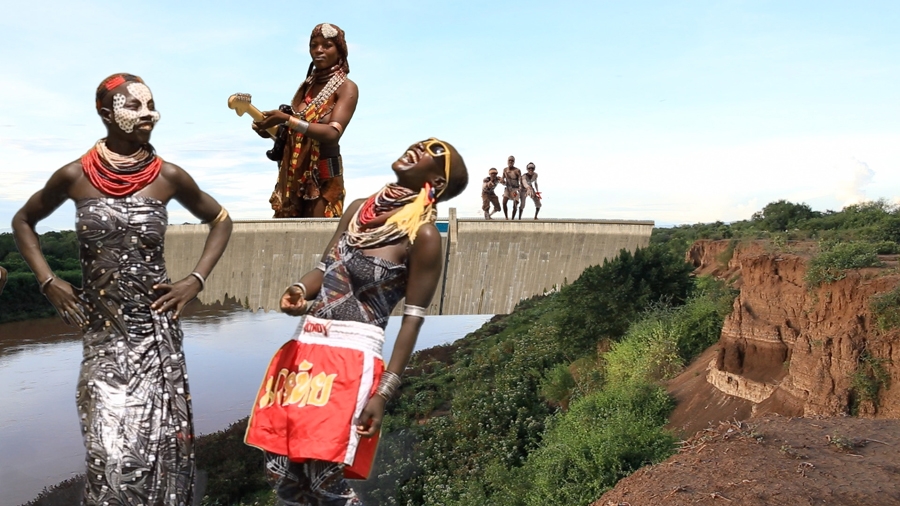In the dense booklet accompanying Glitch, curator Davide Giannella sums up his field of action as ‘the ever-expanding territory disputably labeled as art cinema’. Accordingly, this show maps and regroups the last generation of Italian artists under the banner of their production of moving images (of all formats and lengths, from 2000 onwards), while trying to bridge the gap between two distinct categories of Milanese arty public: that for contemporary exhibitions, and that for film festivals. Quite surprisingly, though, instead of emphasising the hybrid and spectacular nature of expanded cinema, the layout is rigidly split in two: cinema on one side, art on the other. Three large rooms on the ground floor of PAC have been turned into movie theatres, with thick velvety curtains, video projectors and wide screens, to grant the best viewing conditions possible, as an antidote to our indigestion from laptop and iPad screenings. Each room runs (on alternate days) two programmes, in loop, amounting to a total of 64 films and videos produced by around 50 artists and groups, plus a few special screenings of new works (by Rä di Martino, Luca Trevisani, Gianluca and Massimiliano De Serio, Alina Marazzi and Masbedo, for instance) on given evenings.
The rest of the museum is occupied by silent and still installations, sculptures and photographs, the only kinetic exceptions being Rosa Barba’s ‘filmic sculptures’ – 35mm-celluloid spooling around inside shaped objects, activating a rolling bar inside them – Color Clocks: Verticals Lean Occasionally Consistently Away from Viewpoints (2012) and Virgilio Villoresi’s amusing animated flipbooks-cum-typewriter Click, Clack (2014). Most works are related to their cinematic counterparts, and yet presented as autonomous pieces, somehow elliptically. Mastequoia op. 09–13 (2009–13), akin to a giant film roll, runs across PAC for 20 metres and reproduces 34 stills of the visionary, distorted VHS film Mastequoia op. 09–13. Rotterdam, Tokyo, Fès (2013), shot by Gabriele Silli, Giacomo Sponzilli and Carlo Gabriele Tribbioli. The series of triangular white and red signs To Say Nothing of the Dog (#1) (2014), by Ettore Favini and Antonio Rovaldi, suggest possible routes for navigating the exhibition, as they do in reality along the shores of the Po river, in the eponymous travelogue shot by the artists. New Void: The Books (2013–14), by Alessandro Di Pietro, turns into mute printed pages the 945 scanned images from Gaspar Noè’s movie Enter the Void (2009) upon which Di Pietro’s latest film, New Void. The Movie (2013–4), are based – hat tip to the eerie soundtrack by Enrico Boccioletti, aka Death in Plains.
The contrast between the two sections is manifest: one can be viewed relatively quickly, the other is a hostage to extended duration, and thus requires hours and multiple visits. I returned twice, also to take advantage of the small documentary room on the first floor, where all the titles of the programme can be viewed on demand on a touchscreen, somehow contradicting the paradigm of slowness and full immersion proposed downstairs. My personal playlist included Ambaradan (2014), by Alterazioni Video, a caustic music video shot in collaboration with the Ethiopian Karo tribe, doing its best to rip up the ethnographic gaze; Negus – Remembering a Night in Shasha (2014), by Invernomuto, an attempt to reconstruct, via drawings and oral memories but no recorded images, an evening spent together by this duo of artists, videomakers and musicians in the Rastafarian community of Shashamane, again in Ethiopia, as part of their ongoing project Negus; and the lovely Before They Break, Before They Die, They Fly! (2014), by Anna Franceschini, on the magic of levitating objects and moving images. Of course, I couldn’t see everything and felt guilty because of it, as much as being glad to access so much at once, never mind the overload. Damn, I wish I went to art cinema festivals much more often.
This article was firs published in the January & February 2015 issue.
